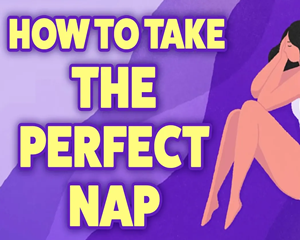Your eyes get heavy and gradually... close... But wait! It's only lunchtime and you still have so much to do.
你的眼皮变得沉重,慢慢地...合上...但等等!才刚到午餐时间,而你还有这么多事情要做。
Would taking a nap help? Or would it derail your day?
打个盹会有帮助吗?还是说这会妨碍你的一天?
Our sleep, both at night and in naps, is made up of approximately 90 minute sleep cycles with four stages each.
我们的睡眠,无论是夜间还是午睡,都是由大约90分钟的睡眠周期组成,每个周期分四个阶段。
A nap can last anywhere from five minutes to three hours, so it can include full sleep cycles or just a few stages.
小睡可以持续5分钟到3小时,所以它可以包括完整的睡眠周期或者只是几个阶段。
As you fall asleep, you enter Stage 1: the first two to five minutes of sleep. Stage 2 comes next, for about 30 minutes.
当你入睡时,你进入了第一阶段:睡眠开始的2-5分钟。接下来是第二阶段,大约30分钟。
In Stage 2, body temperature drops, muscles relax, and breathing and heart rate become more regular.
在第二阶段,体温下降、肌肉放松,呼吸和心率变得更加规律。
Your neurons start to fire in unison, creating waves of activity that sweep across the cortex, punctuated by rapid bursts of neural activity called sleep spindles.
你的神经元开始齐射,产生扫过大脑皮层的活动波,被名为“睡眠纺锤波”的高频爆发神经活动打断并结合。
As you enter Stage 3, or slow wave sleep, the rolling waves increase as your neurons fire in coordination.
当你进入第三阶段,或慢波睡眠时,随着你的神经元协作发射,滚动波增加。
This phase lasts about 20 to 30 minutes and is where your deepest sleep occurs. Then, you enter REM sleep, which lasts about 10 to 20 minutes in a nap.
这个阶段持续约20至30分钟,也是你进入深度睡眠之际。然后,你进入快速眼动睡眠,在小睡中大约持续10至20分钟。
In REM, the brain becomes more active, more like your brain activity while awake.
在快速眼动睡眠时,大脑变得更加活跃,更像大脑清醒时的活动。
The end of REM signals the completion of a sleep cycle. OK, but will a nap make you feel better?
快速眼动睡眠信号结束标志着一个睡眠周期的完成。好吧,但打个盹会让你感觉更好吗?
Well, that depends on a few things -- especially what stages of sleep the nap includes.
那取决于一些要素--尤其是小睡包括哪些睡眠阶段。
Take a 30 minute nap, which consists mainly of Stage 2 sleep.
比方说30分钟小睡,主要包括第二阶段的睡眠。
Stage 2 sleep is associated with long-term potentiation, a process that's thought to strengthen the synapses between neurons, which is essential for learning.
第二阶段的睡眠与长时程增强作用有关,长时程增强作用被认为能加强神经元之间的突触,这对学习至关重要。
A 20 to 30 minute nap stops short of Stage 3′s deep sleep, making it relatively easy to wake up from.
20到30分钟的小睡在第三阶段的深层睡眠前就会停止,因此从睡梦中醒来相对容易。
A 30 to 60 minute nap, meanwhile, has the benefits of Stage 2 sleep and also takes you into the deeper sleep of Stage 3.
30到60分钟的小睡,同样,会带来第二阶段睡眠的好处,也会让你进入第三阶段的深度睡眠。

During Stage 3, multiple brain areas work together to transfer information from short-term memory storage to long-term storage,
在第三阶段,多个大脑区域协同工作将信息从短期记忆储存转移到长期记忆,
stabilizing and strengthening long-term memory by coupling sleep spindles with slow waves.
通过将睡眠纺锤波与慢波耦合,稳定并加强长期记忆。
Stage 3 is the most difficult stage to wake up from.
第三阶段是最难醒来的阶段。
So while a 30 to 60 minute nap can have cognitive benefits, those benefits often don't kick in until about 15 minutes after waking up.
因此,虽然30到60分钟的小睡有利于认知能力,但这些好处往往要到醒后15分钟左右才会显现出来。
60 to 90 minute naps enter the REM stage.
60至90分钟的小睡会进入快速眼动阶段。
While in REM, the prefrontal cortex, which is largely responsible for inhibition and cognitive control, becomes much less active.
而在快速眼动阶段,主要负责抑制和认知控制的前额叶皮层变得不那么活跃。
Meanwhile, the amygdala and cingulate cortex, regions associated with emotion and motivation, are highly active.
同时,杏仁核和扣带皮层,与情绪和动机相关的区域反而高度活跃。
Researchers have posited that the combination of these things leads to bizarre dreams during REM sleep:
研究人员认为,这些现象的结合会在快速眼动睡眠期间催生出怪异的梦境:
the decrease in inhibition and cognitive control might lead to wild associations
抑制和认知控制的减少可能会导致疯狂的联想,
and, thanks to the amygdala and cingulate cortex activity, those associations can be between emotionally charged topics.
而且,由于杏仁核和扣带回皮层的活动,这些联想可能常处在情绪化的话题中。
Some researchers think this stage might help us make innovative connections between ideas upon waking.
一些研究人员认为这个阶段可能有助于我们在醒来后在想法间产生创新的联系。
Because the brain activity during REM is closer to waking, it may be easier to wake up from REM than Stage 3, even though the nap is longer.
因为,大脑活动在快速动眼睡眠期间与清醒时相似,尽管小睡的时间更长,但可能比第三阶段更容易醒来。
The time of day also matters. Our need for deep Stage 3 sleep progressively increases throughout the day.
一天中小睡的时间也很重要。我们对第三阶段深度睡眠的需求在一天中随着时间推移逐渐增加。
So if you nap later, you may rob yourself of the sleep pressure needed to go to sleep at night. This doesn't happen for REM sleep.
因此,如果你晚点打盹,你可能会让自己晚上睡不着。但对于快速动眼睡眠这不成问题。
Longer periods of REM occur during morning hours,
长时间的快速眼动发生在早晨,
so morning naps are dominated by REM, midday naps have about equal parts of REM and deep sleep, and evening naps contain more deep sleep.
所以早晨的小睡主要是快速眼动,中午的小睡有相当部分的快速眼动和深度睡眠,而晚上睡觉多数是深度睡眠。
On top of all this, it seems that we're just about evenly split between nappers and non-nappers.
总之,似乎喜欢小睡和不喜欢小睡的人平分秋色。
Nappers consistently show cognitive benefits from napping, but non-nappers may not.
喜欢小睡的人总是表现出小睡对认知的好处,但不喜欢小睡的人则没有。
Researchers think this could be because nappers are able to stay in a lighter sleep and move through sleep stages more easily.
研究人员认为这可能是因为喜欢小睡的人能够保持较轻的睡眠状态,更容易转换于不同睡眠阶段。
Meanwhile, non-nappers may experience more deep sleep while napping, making them groggy afterward.
同时,不喜欢小睡的人在打盹时可能会经历更多的深度睡眠,让他们醒来后昏昏沉沉。
So will a nap help? Well, there's only one way to find out...
那么小睡一下会有帮助吗?只有一个办法可以知道...


